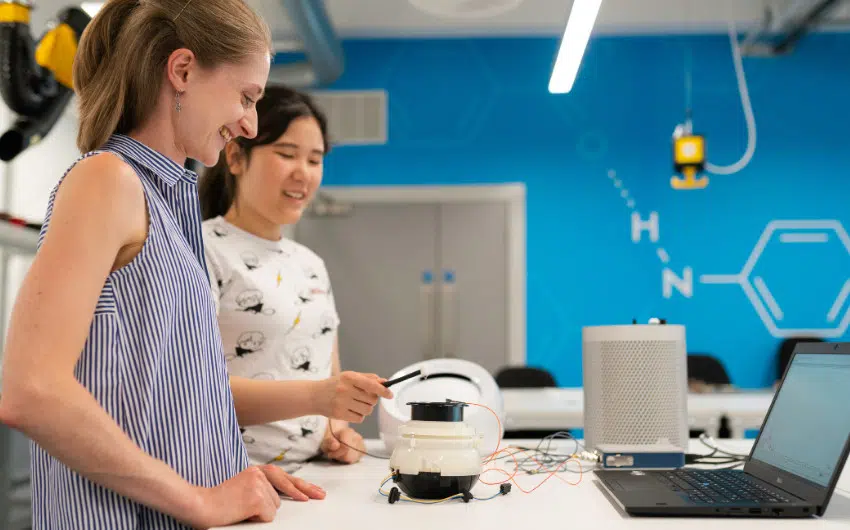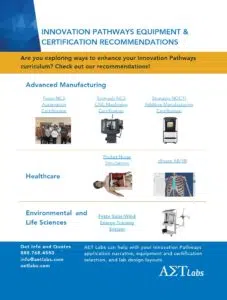Since the program was established in 2017, Innovation Pathways has provided thousands of Massachusetts high school students with equitable educational experiences that expose them to local in-demand career paths. Impact data has shown that Innovation Pathways students are more likely to graduate, have higher attendance rates, and have fewer disciplinary incidents. Are you exploring Innovation Pathways for your district or school? Read on to find out about the program and how to get started.
What is Innovation Pathways?
Innovation Pathways was originally launched in 2017 as part of the "High Quality College and Career Pathways" Initiative under former Massachusetts Governor Charlie Baker. Its goals are to contextualize student learning, engage high school students, and lead students to opportunities for meaningful careers.
The programs have continued under Governor Maura Healey's administration with a goal to "reimagine high school" by engaging students with hands-on learning for in-demand career paths.
Innovation Pathways connect student learning to an industry sector in demand in the Massachusetts economy and guide students to relevant postsecondary education and training. The program is designed to increase equitable access by eliminating barriers to student participation. As of April 2024, the pathways are aligned to these industries:
- Manufacturing
- Information
- Business and Finance
- Environmental and Life Sciences
- Health Care and Social Assistance
- Clean Energy (pilot program)
Participating schools leverage strong partnerships with local MassHire boards and employers to provide students with career awareness and work-based learning activities. In addition to their core academic courses, students take technical courses aligned to industry-recognized credentials and conduct a 100-hour work-based learning experience (internship or capstone).
All Innovation Pathways are designed under five guiding principles:
1: Equitable Access
Prioritize students underrepresented in education enrollment and completion, eliminating barriers to student participation.
2: Guided Academic Pathways
Structured around clear and detailed student academic pathways from secondary to postsecondary education with substantive exposure to career opportunities in high-demand fields.
3: Enhanced Student Support
Incorporate sufficient wraparound services to promote academic success and course completion, taking into consideration the needs of diverse populations of students.
4: Connection to Career:
Expose students to a variety of career opportunities. For example, providing targeted workforce and career skills development, career counseling, and elements of experiential and work-based learning.
5: Effective Partnerships
Innovation Pathways programs require a formal partnership with a workforce development (MassHire) board and/or one or more employers or an employer association.
Designated Innovation Pathways High Schools
As of April 2024, Innovation Career Pathways will be offered in 25% of eligible high schools in Massachusetts at nearly 100 schools with approximately 8,000 students enrolled. Explore this map on the Mass Pathways Map website to see which schools offer designated Innovation Pathways, which pathways, and how many students are enrolled.

Benefits of Innovation Pathways to Schools
The most important benefit of Innovation Pathways is that it allows non-technical schools to provide an education that prepares students for a career after graduation and improves their engagement while they are students. Michael Rubin, Principal at Uxbridge High School, has said about their Innovation Pathways program, "Dropout rates have declined, performance has improved, and student metrics for learning are on the rise."
Innovation Pathways programs also open schools to opportunities for additional grants to purchase equipment or fund professional development. For example, designated Innovation Pathways schools are eligible to apply for the Massachusetts Skills Capital Grant Program, awarding $20 million to schools for FY24. In addition, Innovation Pathways programs may qualify for federal Perkins funding if the programs meet specific criteria outlined in the Innovation Career Pathway Criteria document.
Benefits of Innovation Pathways to Students
Innovation Pathways has given more students in Massachusetts career-focused opportunities while in high school. Students who would have been waitlisted from CTE programs at vocational high schools now benefit from valuable career exploration at their local high school to help them transition to a career or college after graduation. Students in Innovation Pathways get college credits at no cost to them and 100 hours of work-based learning, giving them relevant on-the-job experience while still in high school.
How to Apply for Innovation Pathways
Massachusetts school districts or charter schools can apply for the Innovation Pathways program. However, they must collaborate with a local MassHire Board and an employer partner as a supporting partner, evidenced by a letter of agreement.
There is a two-part application process for Innovation Pathways. The Part A application is to show that the school has completed sufficient planning and design of the program in alignment with the guiding principles and is due in October. A team from DESE and EOE evaluates the application. The applicants that are approved in Part A are invited to submit Part B applications.
The Part B Final Designation application is due in February. The applicant must fulfill essential elements of the Innovation Pathways program design and provide sufficient evidence of enrolled students or a plan for enrolling students by the following fall semester. See the Innovation Pathways webpage for the detailed application schedule.
Final designations are issued as five-year performance contracts, with annual reporting obligations, opportunities for participation in technical assistance, and a review/check-in after the first three years.
AET Labs Can Help
Over the past five years, AET Labs has helped many high schools with their Innovation Pathways application, including Fitchburg, Shepherd Hill, Gardner, and Woburn. They have gone on to launch, sustain, and grow successful pathways.
Please contact us to get help with your application and find out how other Massachusetts schools are implementing their Innovation Pathways.


